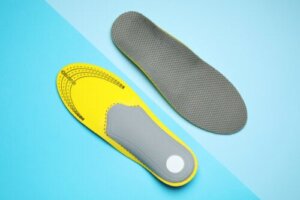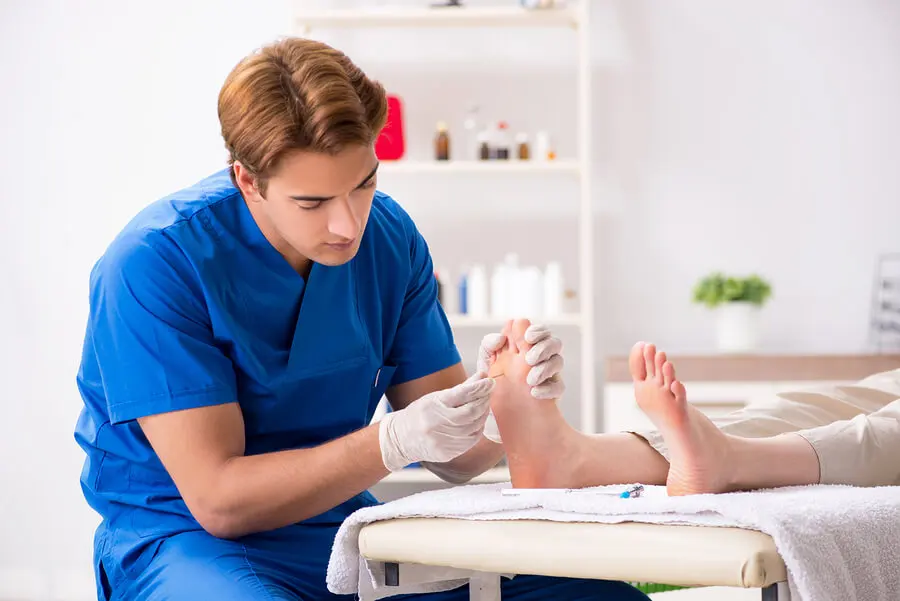Running Insoles: The Benefits and Who Should Use Them


Reviewed and approved by the doctor Leonardo Biolatto
Sports activities, especially when practiced frequently and intensely, require the use of appropriate equipment. This includes the incorporation of adapted footwear, including running insoles. This is an element that helps to improve bad posture in order to prevent injuries.
Some sports and exercises tend to force impacts against the ground, which can cause discomfort in the feet. Running insoles not only correct ailments in that area, but also in the spine and knees. However, not everyone should use them.
What are running insoles and what are their main benefits?
Running insoles are adaptable elements that are inserted into footwear in order to improve the athlete’s stride. Many are made from materials such as ethylene-vinyl acetate, better known as EVA rubber, and work by cushioning the footprint to accommodate the foot and prevent injuries.
By wearing them, it’s also possible to treat some existing ailments. However, the main function is to reduce the damage caused by forced postures.
With today’s technology, sports shoes are already manufactured with specific specifications for runners. However, there are situations in which plantar supports are necessary.
In addition to protecting the feet and cushioning impacts, running insoles help to solve problems related to the legs and spine. For example, such is the case of scoliosis or spinal deviation.
Cases in which running insoles are recommended
Many athletes with foot abnormalities, as well as frequent overloads or injuries, often incorporate the use of running insoles. There are low-impact activities, such as golf or hiking, that require only appropriate footwear. However, if those who practice them have previous problems, insoles are recommended anyway.
In other more physically demanding sports, with turns, jumps, or blows on the foot, their use is even more indicated. For example, this includes track and field, running, basketball, rugby, or soccer. The feet have the capacity to support more than twice the body weight. However, adding a protective accessory helps to take care of them and to prevent injuries.

Other reasons to wear running insoles
Different anomalies and conditions that are concentrated in the feet, legs, or spine also justify the application of running insoles. They can prevent the appearance of these problems or improve the footprint if they already exist, as well as prevent the appearance of new ailments due to poor posture:
- Varus foot: This is the situation in which the back of the foot is aligned outwards in relation to the ground. It usually causes exaggerated impacts on the heel and the fifth metatarsal.
- Valgus foot: In this case, also known as flat foot, the deviation is aligned inward.
- Calcaneal spur: This is a bony growth developed around the heel bone.
- Plantar fasciitis: Inflammation of the fibrous tissue on the bottom of the foot that can cause severe heel pain.
- Achilles tendinopathies are injuries to the Achilles tendon. Very common in athletes and middle-aged people.
- Metatarsalgia: Inflammation in the ball of the foot or metatarsal. It manifests with deformities in the toes or the appearance of calluses.
Finally, running insoles can be useful in conditions that are not primarily concentrated in the feet. For example, in cases of limb dysmetria – that is, when you have a leg shorter than the other, something that makes the meniscus work more.
Also, they may be recommended by a doctor when you suffer from alterations in the axes of the knees. This is known as genu valgus, when they are inward, and genu varum when they are outward.
We think you may also enjoy reading this article: 4 Tips to Eat the Right Breakfast Before Going Running
Professionals who can prescribe the use of running insoles
In everything that has to do with foot health, the role of a professional podiatrist is fundamental. This includes an instance of prevention and one of treatment when the problem or injury is already installed.
In addition, other professionals, such as traumatologists or sports doctors, are also qualified to prescribe insoles. The evaluation of each patient’s condition is carried out through a footprint study.
Among the aspects evaluated are the shape of the footprint, any existing injuries, and the condition of the muscles and joints. With the results, it’s possible to know what type of footwear is the most appropriate for that person and whether the use of insoles is necessary.

What can you expect from running insoles?
The main function of insoles is to improve foot support, so as to prevent exaggerated stresses on muscles and joints. They also contribute to the prevention of sprains, tendinitis, and overloads.
These elements tend to correct and improve the alignment of the footprint, providing a more effective forefoot take-off and complete support of the sole. In general, the effects of their use improve athletic performance.
Like this article? You may also like to read: 11 Exercises to Improve Your Running Technique
Getting a doctor’s opinion is always a good idea
Apart from the conditions or anomalies that justify the application of insoles, there are other situations in which runners or athletes are unaware of their existence. In the case of repeated injuries or constant overloads in the same area, it’s a good idea to consult a podiatrist.
Also, if you notice any of the aforementioned problems or aren’t sure how to use insoles correctly, it’s best to visit a professional. He/she will evaluate the possibility of incorporating insoles.
All cited sources were thoroughly reviewed by our team to ensure their quality, reliability, currency, and validity. The bibliography of this article was considered reliable and of academic or scientific accuracy.
- Alfonso Mora, Margareth Lorena et al. “Dinámica Plantar Durante Un Circuito de Habilidades Técnicas Básicas En Fútbol.” Revista Andaluza de Medicina del Deporte 11.4 (2018): 217–220. Disponible en: https://doi.org/10.33155/j.ramd.2018.06.003
- Parra García, JI., Bueno Sánchez, A., El pie plano; las recomendaciones del traumatólogo infantil al pediatra. Pediatría Atención Primaria [Internet]. 2011;XIII(49):113-125. Recuperado de: https://www.redalyc.org/articulo.oa?id=366638728012
- “Efectos de Los Soportes Plantares Sobre La Termorregulación de Las Plantas de Los Pies Durante La Carrera.” Biomecánica (2015). Disponible en: https://doi.org/10.5821/sibb.23.1.5147
- Rupcich, Marcel, Bravo, Ricardo, Cerrolaza, Miguel, MANEJO DEL RETROPIÉ PLANO VALGO FLEXIBLE CON LA FÉRULA TIPO UCBL EN PACIENTES PEDIÁTRICOS. Archivos Venezolanos de Puericultura y Pediatría [Internet]. 2010;73(1):10-13. Recuperado de: https://www.redalyc.org/articulo.oa?id=367937039004
- Ogueta-Alday, Ana, García-López, Juan, Factores que afectan al rendimiento en carreras de fondo. RICYDE. Revista Internacional de Ciencias del Deporte [Internet]. 2016;XII(45):278-308. Recuperado de: https://www.redalyc.org/articulo.oa?id=71046278006
This text is provided for informational purposes only and does not replace consultation with a professional. If in doubt, consult your specialist.








